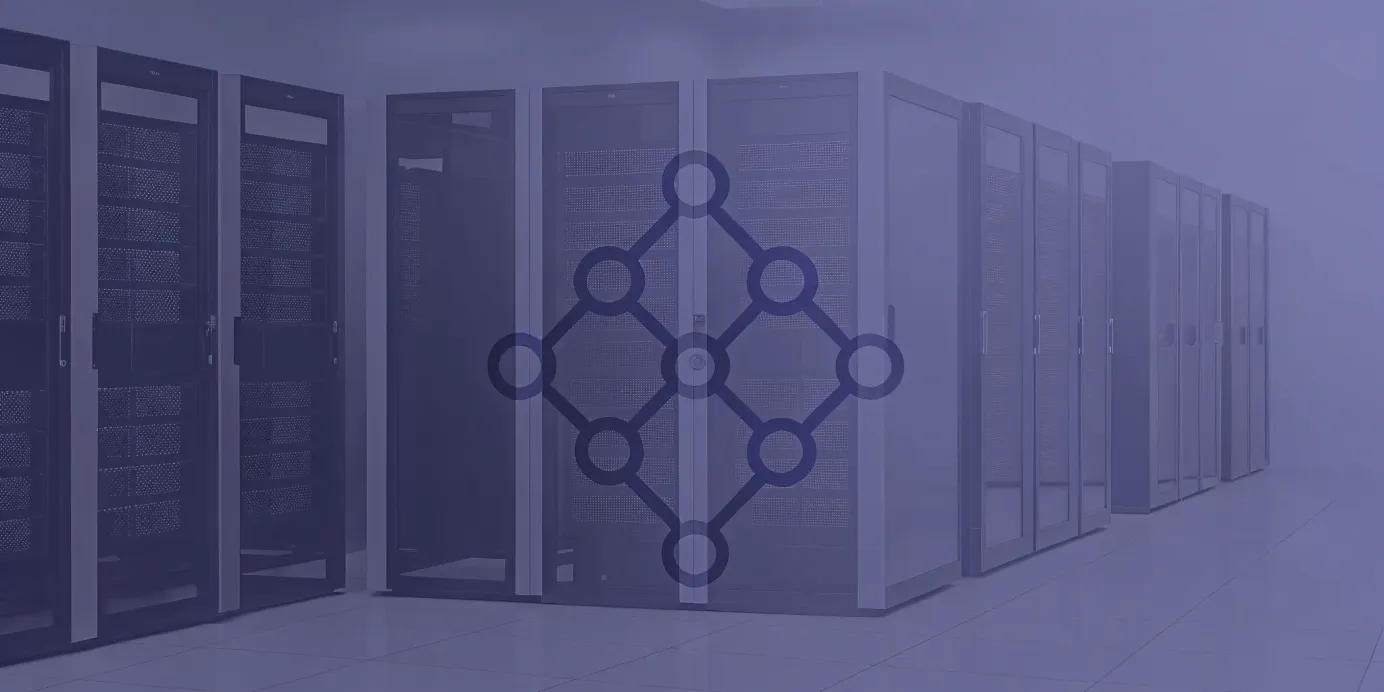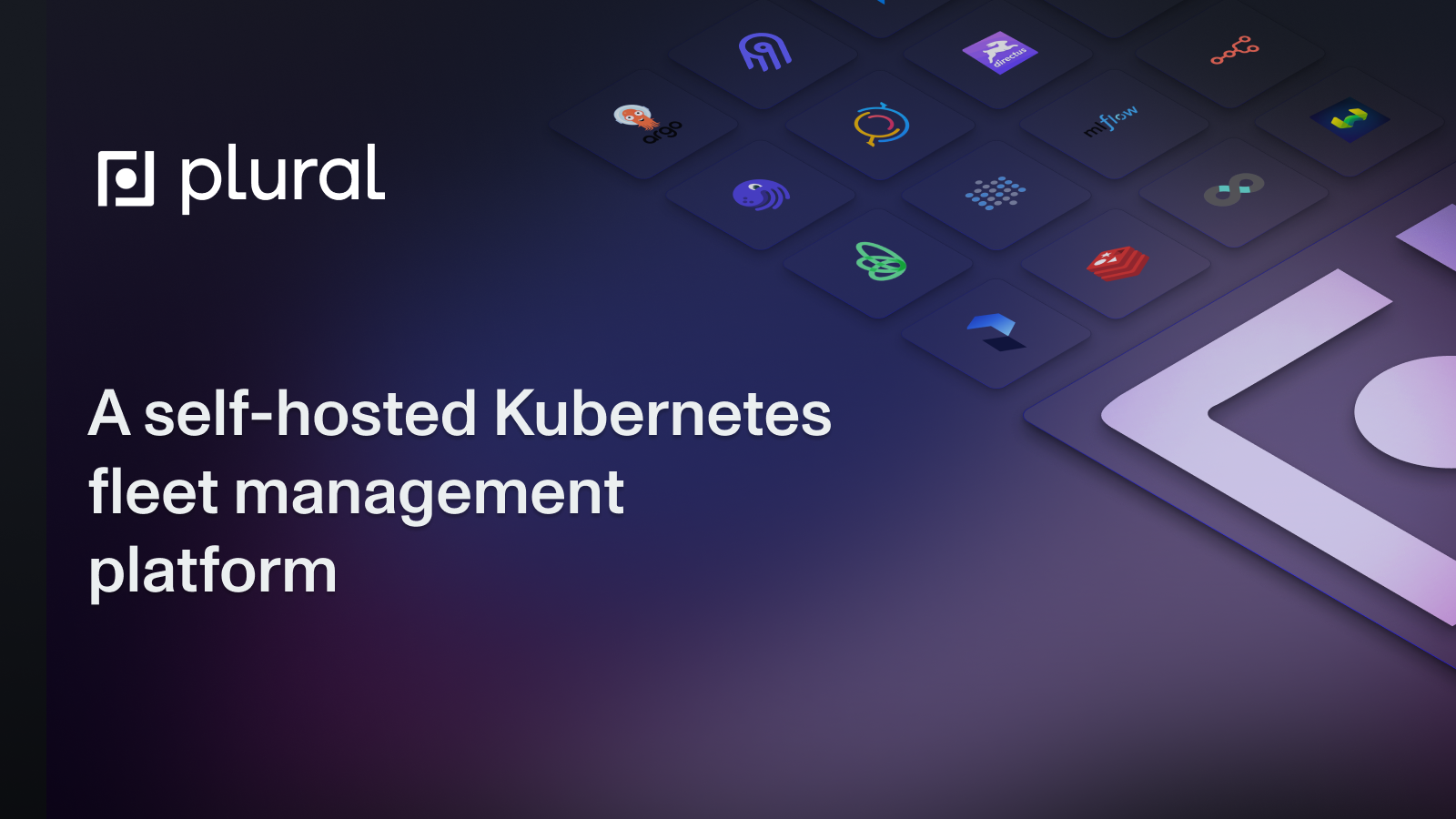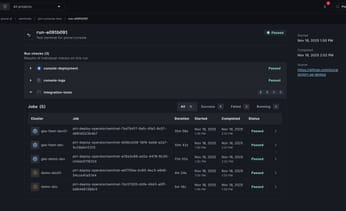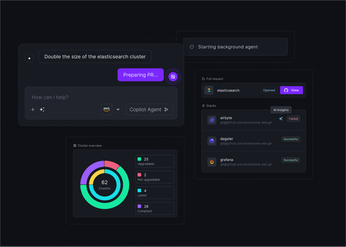
Platform Engineering on Kubernetes: Benefits, Tools, and Best Practices
Learn about platform engineering on Kubernetes, its benefits, essential tools, and best practices to streamline software development and deployment.
Kubernetes has revolutionized how we deploy and manage applications, but its inherent complexity can create challenges for development teams. Platform engineering on Kubernetes addresses this by providing a simplified and standardized developer experience. By abstracting away the complexities of Kubernetes, platform engineering empowers developers to focus on building and shipping features.
Join us as we explore the key benefits of platform engineering on Kubernetes, the essential components and tools, and how to implement a successful platform engineering strategy. We’ll also examine how solutions like Plural help organizations build an Internal Developer Platform (IDP) that simplifies Kubernetes operations while empowering developers with self-service capabilities.
Unified Cloud Orchestration for Kubernetes
Manage Kubernetes at scale through a single, enterprise-ready platform.
Key Takeaways
- Simplify Kubernetes with platform engineering: Abstracting away infrastructure complexities lets developers focus on building and shipping features quickly, leading to faster release cycles and improved developer experience.
- Kubernetes is the foundation of modern platforms: Kubernetes container orchestration capabilities are essential for building scalable and reliable platforms. Platform engineering makes Kubernetes more accessible to development teams, accelerating software delivery.
- Invest in tooling and expertise: Effective platform engineering requires the right tools and a skilled team to manage the platform and support developers. Prioritize continuous improvement and developer experience for long-term platform success.
- Empower developers with self-service capabilities: With Plural, organizations can create an Internal Developer Platform (IDP) that simplifies Kubernetes operations while empowering developers with self-service capabilities.
What is Platform Engineering on Kubernetes?
Platform engineering is becoming increasingly critical for organizations that want to streamline their software development and deployment processes. It involves building and maintaining an internal developer platform—a self-service layer—that provides developers with the tools and resources they need to build, deploy, and manage applications efficiently.
Kubernetes plays a pivotal role in modern software development, particularly within the context of platform engineering. As the industry-standard container orchestrator, Kubernetes provides the foundation for managing and scaling containerized applications. However, managing Kubernetes itself can be complex, especially at scale. Platform engineering addresses this challenge by providing a simplified interface for interacting with Kubernetes, abstracting away much of the underlying complexity. This allows developers to leverage the power of Kubernetes without needing deep expertise in its intricacies.
Benefits of Platform Engineering on Kubernetes
Platform engineering on Kubernetes offers several key benefits that empower organizations to develop, deploy, and manage applications more effectively.
Deliver Software Faster
Platform engineering on Kubernetes enables faster software releases by providing development teams with self-service tools and automated workflows. This reduces the friction associated with infrastructure provisioning, configuration, and deployment, allowing developers to focus on building and shipping features.
Enhance Developer Experience
Platform engineering prioritizes a positive developer experience. By creating and maintaining a structured environment, platform teams empower developers with the tools and resources they need to be productive. Self-service capabilities, automated workflows, and standardized processes eliminate tedious tasks and reduce cognitive load, allowing developers to focus on writing code.
Streamline Operations and Manage Resources
Platform engineering streamlines operations and optimizes resource management by implementing best practices and automation. Platform teams can achieve operational excellence, avoid outages, and build a secure, resilient Kubernetes foundation by learning from others' mistakes and embedding best practices.
Essential Platform Engineering Components
This section explores the essential components and tools that empower platform engineers to build and manage robust, scalable platforms on Kubernetes.
Orchestrate Containers with Kubernetes
Kubernetes has become the industry standard for container orchestration, enabling efficient deployment, management, and scaling of containerized applications. It automates tasks like deployment, scaling, and networking, freeing platform teams to focus on higher-level concerns. Platform engineers leverage Kubernetes to provide a stable and scalable foundation for application deployments.
Integrate CI/CD Pipelines
Continuous integration and continuous delivery (CI/CD) pipelines are fundamental to platform engineering. Automating the build, test, and deployment process accelerates software delivery and improves developer productivity. Tools like Tekton, Argo CD, and Flux CD allow platform engineers to design and implement these pipelines, integrating them with Kubernetes to streamline deployments and rollbacks.

Use Infrastructure as Code (IaC)
Infrastructure as Code (IaC) is crucial for managing Kubernetes infrastructure and applications in a repeatable and scalable manner. Tools like Terraform and Pulumi allow platform engineers to define and manage infrastructure through code, enabling version control, automated provisioning, and simplified infrastructure management. For example, Plural's IaC management allows you to implement a GitOps strategy around your Terraform, Pulumi or Ansible workflow.

Implement Observability and Monitoring
Observability and monitoring are essential for maintaining the health and performance of Kubernetes platforms. Implementing robust monitoring and logging solutions provides insights into application behavior, resource utilization, and potential issues. Tools like Prometheus and Grafana enable platform teams to collect metrics, visualize data, and set up alerts, allowing for proactive issue identification and resolution. Learning from operational experiences and implementing best practices helps platform teams avoid outages and build resilient Kubernetes foundations.

Popular Platform Engineering Tools
Several tools have become popular within the platform engineering ecosystem for managing Kubernetes:
- Helm: Helm acts as a package manager for Kubernetes, simplifying the definition, installation, and upgrade of complex applications. It uses Helm charts to package Kubernetes resources, making deployments more manageable and repeatable.
- Tekton: Tekton is a powerful open-source framework designed for building CI/CD systems on Kubernetes. It allows platform engineers to define and run pipelines within Kubernetes, leveraging its scalability and resilience. Tekton's integration with Kubernetes simplifies pipeline management and execution.
- Argo CD & Flux: Argo CD and Flux are both a declarative, GitOps-based continuous delivery tool specifically built for Kubernetes. It enables teams to manage application deployments and lifecycles by synchronizing the desired state from a Git repository to the cluster.
- Crossplane: Crossplane extends the Kubernetes API to manage cloud resources, providing a unified control plane for applications and infrastructure. This simplifies multi-cloud deployments and allows platform engineers to manage everything through Kubernetes.
- Prometheus and Grafana: Prometheus, a monitoring and alerting toolkit, combined with Grafana, a visualization tool, provides comprehensive insights into Kubernetes cluster performance. These tools are essential for monitoring application health, resource usage, and identifying potential issues.
Implement Platform Engineering on Kubernetes
Implementing platform engineering on Kubernetes is an iterative process. It requires careful planning, the right tooling, and a commitment to continuous improvement.
Build an Implementation Roadmap
Start by assessing your organization's infrastructure, application landscape, and team structure. Identify key pain points and define clear objectives for your platform. A well-defined roadmap should outline the steps, timelines, and resources required for successful platform engineering implementation. Consider starting with a pilot project to validate your approach and gain early feedback. Adopting Kubernetes can be complex, especially in organizations with diverse teams and complex deployments. A clear roadmap helps manage this complexity.
Standardize Deployments
Standardization is crucial for scalability and maintainability. Establish clear guidelines for containerization, configuration management, and deployment processes. This ensures consistency across different applications and environments. Leveraging best practices from the start helps platform teams achieve operational excellence and avoid costly mistakes.
Implement GitOps Workflows
GitOps provides a declarative approach to infrastructure management, using Git as the single source of truth. This enables version control, automated deployments, and easy rollback capabilities. Tools like Argo CD and Flux can help implement GitOps workflows, providing a streamlined and auditable deployment process.
Automate Security and Compliance
Security should be integrated into every stage of the platform lifecycle. Implement automated security scanning, vulnerability management, and policy enforcement. Tools like Trivy and Kube-bench can help automate security checks and ensure compliance with industry regulations. Automating these processes simplifies implementing DevSecOps best practices.
Foster Continuous Improvement
Platform engineering is an ongoing journey. Establish feedback loops with development teams to gather insights and identify areas for improvement. This iterative approach ensures that your platform remains aligned with evolving business needs and delivers maximum value. Platform engineering aims to provide pre-built solutions to internal teams, so their feedback is essential.
Platform Engineering on Kubernetes Challenges and Best Practices
Adopting platform engineering on Kubernetes requires addressing key challenges and implementing best practices.
Address Kubernetes Complexity and Skills Gap
Kubernetes introduces complexity, especially when working across multiple teams, cloud providers, and tech stacks. Platform teams must establish transparent processes for managing deployments, configurations, and resources across these diverse environments.
Finding engineers proficient in Kubernetes can be difficult. With the rise of platform engineering, organizations are increasingly recognizing the need for specialized platform teams. These teams act as internal providers of reusable services and tools, effectively bridging the skills gap. Investing in training and development for your platform team is crucial. Providing access to relevant certifications and fostering a culture of continuous learning empowers your team to manage and support your Kubernetes platform effectively.
Secure Your Platform
Security is paramount in any Kubernetes environment. Building a secure platform requires a multi-layered approach, encompassing everything from secure container images to network policies and role-based access control (RBAC). Consider using policy-as-code tools like Kyverno to automate security enforcement and ensure consistent application of security policies across your entire Kubernetes infrastructure.
Optimize Costs
Kubernetes can be resource-intensive, and managing costs effectively is essential for long-term sustainability. It is crucial to provide both the platform and development teams with visibility into the cost implications of their architectural decisions. Implement resource quotas and limits to prevent runaway costs and leverage tools that provide cost analysis and optimization recommendations, such as Kubecost.
Build an Internal Developer Platform (IDP) on Kubernetes with Plural
Building an IDP allows organizations to streamline Kubernetes operations, empower their developers, and maintain the security and compliance required for modern, scalable software development.
With Plural, organizations can create an IDP that simplifies Kubernetes operations while empowering developers with self-service capabilities. Plural automates workflows, enforces policy compliance, and provides centralized control, empowering development teams to access the tools and environments without infrastructure support.
Accelerate developer workflows
Enable developers to access and deploy Kubernetes resources without relying on infrastructure teams. Plural’s self-service model reduces bottlenecks and streamlines development pipelines.

Ensure consistent environments across teams
An IDP must provide uniform environments to avoid discrepancies in development, staging, and production. Plural ensures consistency while allowing flexibility for unique team needs.

Empower teams with policy-driven access
Provide developers with the access they need while maintaining compliance and security standards. Plural’s centralized policy management ensures resources are created and used correctly.

Simplify Kubernetes operations
Managing Kubernetes clusters can be overwhelming without the right tools. Plural's Operations Console brings everything developers need into one platform, simplifying the operational complexity.

Ready to transform your Kubernetes experience?
Try Plural today and empower your developers with a modern, self-service Internal Developer Platform.

Related Articles
Unified Cloud Orchestration for Kubernetes
Manage Kubernetes at scale through a single, enterprise-ready platform.
Frequently Asked Questions
How does platform engineering differ from traditional DevOps practices?
While both platform engineering and DevOps share the goal of streamlining software delivery, they approach it from different angles. DevOps often focuses on collaboration and shared responsibility between development and operations teams, sometimes leading to context switching and diluted expertise. On the other hand, platform engineering establishes a dedicated platform team responsible for building and maintaining the internal developer platform. This team creates a self-service layer, abstracting away infrastructure complexities and empowering developers to work independently with pre-built tools and golden paths. This separation of concerns allows developers to focus on building features while the platform team ensures a stable and efficient operational environment.
What are the key considerations when choosing a Kubernetes distribution for platform engineering?
Choosing the right Kubernetes distribution depends on several factors, including your organization's size, technical expertise, and desired level of control. Managed Kubernetes services like Amazon EKS, Google GKE, or Azure AKS offer convenience and reduced operational overhead, making them suitable for organizations that prefer a hands-off approach. Self-managed Kubernetes, while requiring more expertise, provides greater flexibility and control over your environment. Consider factors like scalability requirements, security needs, integration with existing infrastructure, and the availability of in-house Kubernetes expertise when making your decision.
How can we address the skills gap in Kubernetes and platform engineeringour organization's?
The demand for Kubernetes and platform engineering skills often outpaces supply. Address this gap by investing in training and development programs for your existing engineers. Look for opportunities to upskill team members through online courses, certifications (like CKA or CKAD), and hands-on workshops. Consider partnering with external consultants or managed service providers to supplement your team's expertise during the initial implementation phases. Building a strong internal platform team with dedicated Kubernetes expertise is crucial for long-term success.
What are the best practices for securing a Kubernetes platform built for platform engineering?
Security should be a top priority when designing and implementing your Kubernetes platform. Implement a multi-layered approach that includes secure container images, network policies, role-based access control (RBAC), and regular security audits. Integrate security scanning into your CI/CD pipelines to identify vulnerabilities early in development. Use policy-as-code tools to automate security enforcement and ensure consistent application of security policies across your clusters. Stay up-to-date with the latest security best practices and vulnerabilities within the Kubernetes ecosystem.
How can we measure the success of our platform engineering initiatives on Kubernetes?
Define clear metrics to track the effectiveness of your platform engineering efforts. Focus on metrics that align with your overall business goals, such as increased developer productivity (measured by deployment frequency, lead time for changes), improved application reliability (measured by mean time to recovery), and reduced operational costs. Gather feedback regularly from development teams to assess their satisfaction with the platform and identify areas for improvement. Continuously monitor and analyze these metrics to demonstrate the value of your platform and guide future development efforts.
Newsletter
Join the newsletter to receive the latest updates in your inbox.











